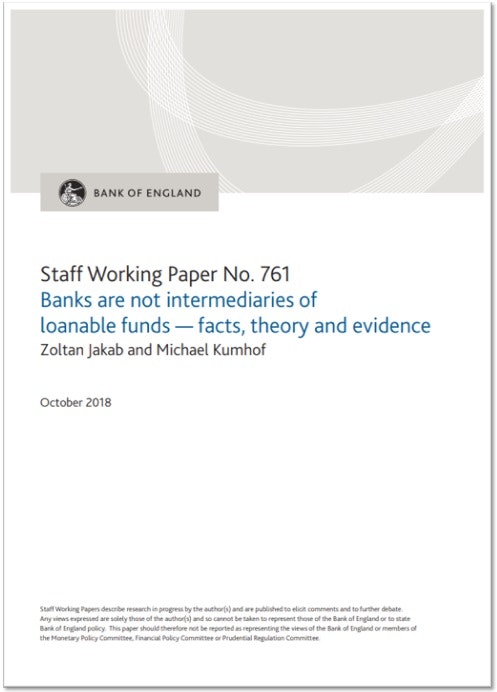New Bank of England research adds to the case against loanable funds


Understanding banks hasn’t always caused such difficulty for economists. In the first half of the twentieth century, theorists like Joseph Schumpeter outlined the role of banks in creating and allocating money.
Unfortunately, the profession took a wrong turn in the 1960s. By the turn of the millennium, macroeconomics had developed something of a blind spot on the issue. In the run-up to the financial crisis that began in 2007, the notion that banks might be critical to the functioning of the economy as a whole interested only a minority of savvy commentators and heterodox thinkers.
Following the financial crisis, this significant shortcoming was reversed – but only partly. While the banking system began to attract much more academic attention, the models used to study it often perpetuated long-standing myths about the way banks actually work. That is the error that Zoltan Jakab and Michael Kumhof, authors of a recent working paper published by the Bank of England, are keen to correct.
The new paper is clear about where the issue lies. Entitled ‘Banks are not intermediaries of loanable funds – facts, theory, and evidence’, it elaborates on an argument the pair made in a paper published in 2015. Their objective is to debunk the loanable funds approach to modelling the banking sector’s role in the economy.
The family of models they describe as the ‘intermediation of loanable funds’ (ILF) is still prominent in the literature. This is surprising, given that it is well established that banks are creators of money and not plain intermediaries of funds. Moreover, ILF models fail to describe the speed and scale of variations in bank balance sheets. Consequently, they also fail to represent the effect of banking sector developments on the wider economy with any accuracy.
A tale of two models
ILF models present banks as warehouses and money as a commodity. In this story, savers come along to store their wealth in a bank for safekeeping; the bank obliges, and uses those funds to extend loans to new customers. According to this perspective, lending and deposit-taking are physical rather than financial transactions, because they simply move existing deposits to different accounts within the banking system.
Official publications by central banks reveal this conventional depiction of bank operations to be completely false. Nevertheless, some authors have made the case for preserving ILF models for theoretical simplicity.
In response, Jakab and Kumhof’s work contributes to a body of evidence as to why ILF models produce chronically inaccurate understandings of how banking affects the wider economy. In place of ILF, they propose using ‘financing through money creation’ (FMC) models. The main technical difference is that instead of featuring a depositor household and a borrower entrepreneur with two separate budget constraints, it features a single budget constraint for a ‘borrower-cum-depositor household’. This helps recognise the facts of money creation in the modern economy: that banks create money when they extend loans. This changes the relationship of bank loans to income in the economy:
‘in turn this new purchasing power, by mobilizing resources that would otherwise have remained idle, triggers increases in the economy’s post-loan income flow.’
The recent paper highlights a particular deficiency of ILF models. They are unable to generate results that match the volatility of bank balance sheets, and the subsequent impact on the real economy, seen in the real world.
This being a paper about economic models, the devil is in the detail. The fundamental difference between ILF and FMC is the causality between deposits and loans.
ILF models assume that deposits are required by banks to make loans. Those deposits are determined by the preferences of households to spend or save, as modelled by household budget constraints. Because households smooth their saving and spending decisions over time, ILF can only produce a small degree of volatility.
FMC models reverse this causality: loans create deposits, subject to households’ preferences over gross financial stocks. That allows for much greater volatility in bank balance sheets.
FMC models therefore convey the fact that banks face no ‘technical’ limit to expanding their balance sheets – that is, savings are not required to make loans. However, they do face economic limits, including ‘their own and their customers’ potentially very volatile expectations regarding future profitability and solvency.’ These factors have a strong influence on the demand and supply of loans and (in the FMC case) deposits.
FMC models harness those volatile expectations to generate volatility in bank balance sheets. They produce predictions that are ‘qualitatively in line with the data’, conveying that:
‘…changes in the size of financial sector balance sheets are large and rapid, that the leverage of aggregate banking systems is procyclical, and that financial crashes have a large credit rationing component.’
Since its founding, Positive Money has sought to expose the myth at the heart of ILF models. Unfortunately, as Jakab & Kumhof note, such models still ‘almost completely dominate the models used in policymaking institutions.’ Their latest paper is an important addition to a growing pile of research against preserving such a faulty approach. Until policymakers start making decisions based on how banks actually function and recognise banks’ unique role in economic life, how can they expect to limit the dramatic impact on our collective prosperity which results every time the banking system catches a cold?